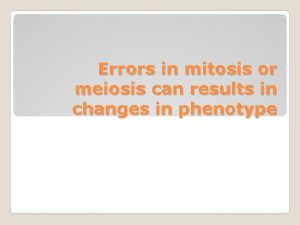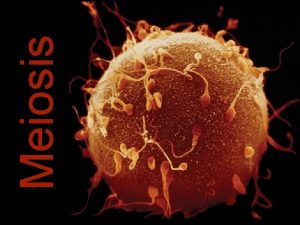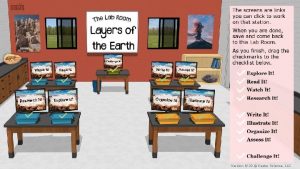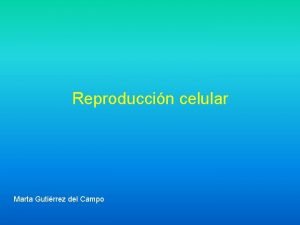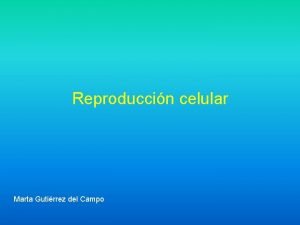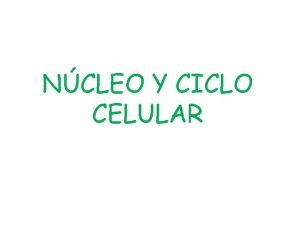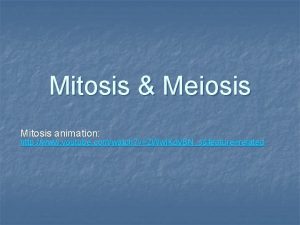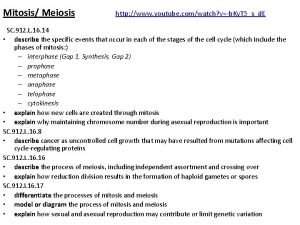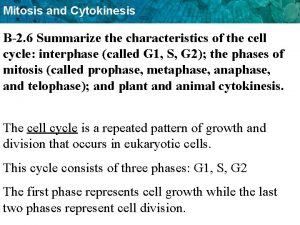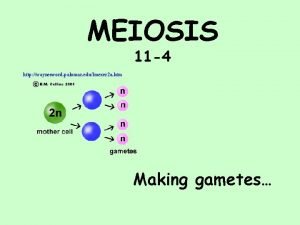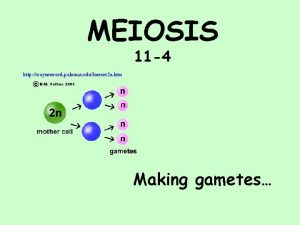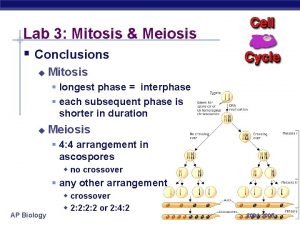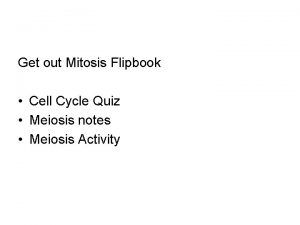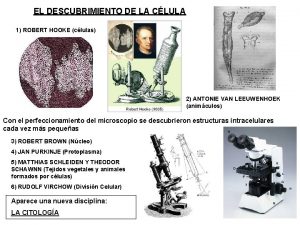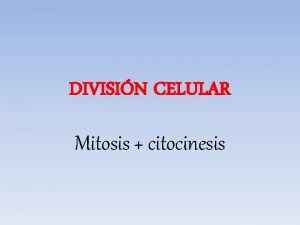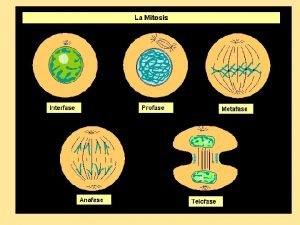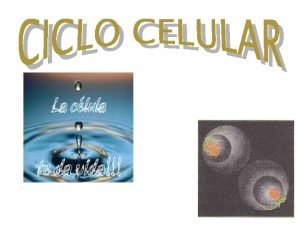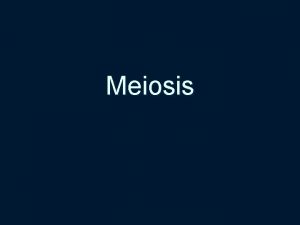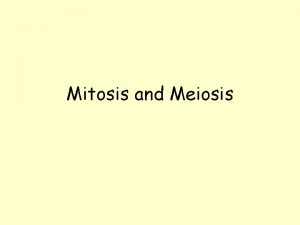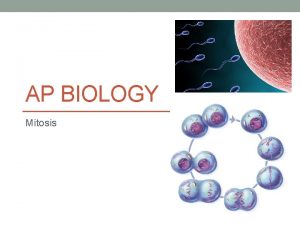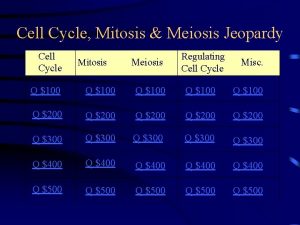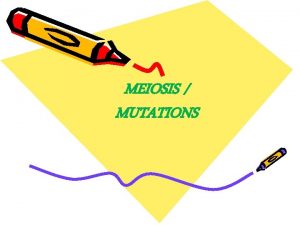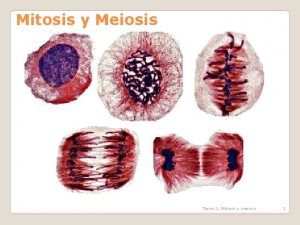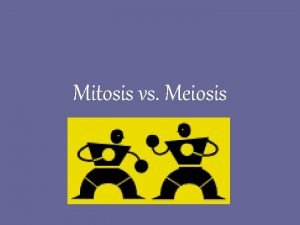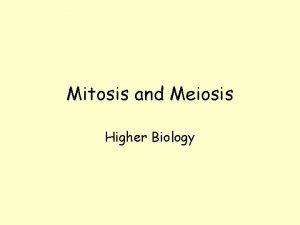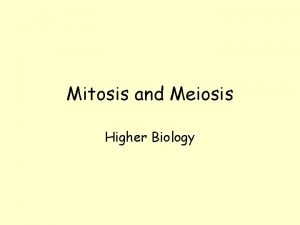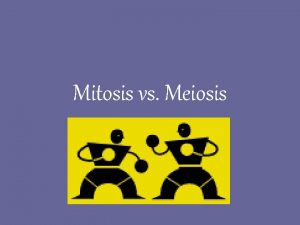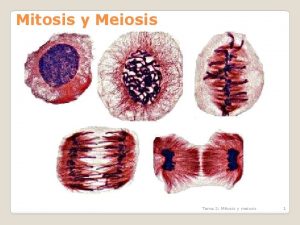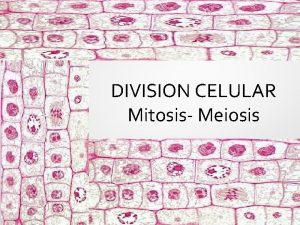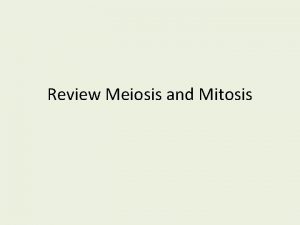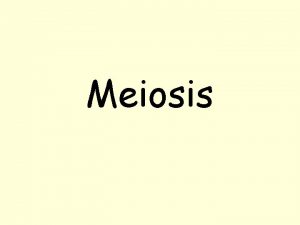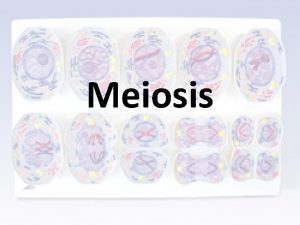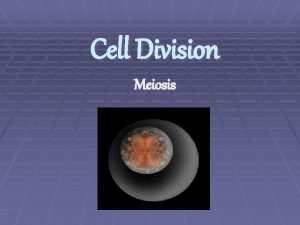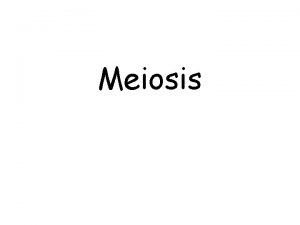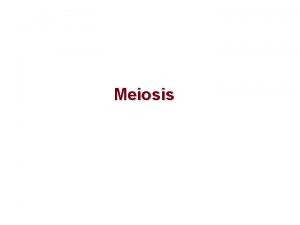Mitosis Meiosis MITOSIS Mytoesis The process of cell
































- Slides: 32

Mitosis & Meiosis

MITOSIS (My-toe-sis) The process of cell division which results in the production of two daughter cells from a single parent cell. The daughter cells are identical to one another and to the original parent cell. Every different type cell in your body contains the same genes, but only some act to make the cells specialize – e. g. into nerve or muscle tissue.

MITOSIS Through this process, a nucleus divides to form two identical NUCLEI. Each new nuclei contains the same number and type of chromosomes.

Chromosomes Play an important part in cell division, also called chromatin Structures in the nucleus that contain DNA. You have 46 of them in your cells (23 pairs). One came pairs from mom and one from dad. The pairs are held together mom dad by a centromere Diagram:

Parent cell Chromosomes are copied and double in number Chromosomes now split 2 daughter cells identical to original

Stages of Mitosis Interphase Prophase Metaphase Anaphase Telophase Cytokinesis

1. 2. 3. 4.

Interphase The cell prepares for division DNA is replicated Organelles are replicated Cells increase in size Chromosomes appear as threadlike coils (chromatin)

Interphase Animal Cell Plant Cell

Prophase The cell prepares for nuclear division Packages DNA into chromosomes Each chromosome now exists as a pair of chromatids joined together by a centromere. Centrioles (or poles) appear and begin to move to opposite ends of cell Spindle fibers form between the poles Nuclear membrane disappears

Prophase Animal Cell Plant Cell

Metaphase The cell prepares chromosomes for division Chromatids (or pairs of chromosomes) attach to the spindle fibers Chromosomes line up at the center of the cell. Spindle fibers attach from daughter cells to chromosomes at the centromere.

Metaphase Animal Cell Plant Cell

Anaphase The chromosomes divide Spindle fibers pull chromosomes apart. The centromeres split and the two chromatids of each double chromosome separate. The chromatids of each pair are then dragged to the opposite ends of the cell

Anaphase Animal Cell Plant Cell

Telophase The cytoplasm divides The group of chromatids assemble at opposite ends of the cell. The spindle fibers disintegrate and a nuclear envelope forms around the chromosomes at each end.

Telophase Animal Cell Plant Cell

Cytokinesis Cell membrane/cell wall pinches in and forms two daughter cells.

Plant Cell Mitosis—same process with a few twists! Because plant cells have rigid cell walls, they do not pinch apart like animal cells do. Instead, they form a structure called a cell plate, where a new cell wall will form. Also, plant cells don’t have centrioles.

Mitosis Animation http: //www. cellsalive. com/mitosis. htm Brain Pop Mitosis – Brain. POP Cell Division http: //kcts 9. pbslearningmedia. org/asset/lsp s 07_int_celldivision/

MEIOSIS (My-oh-sis) Meiosis is the type of cell division by which germ cells (eggs and sperm) are produced. One parent cell produces four daughter cells. Daughter cells have half the number of chromosomes found in the original parent cell.

MEIOSIS During meiosis, DNA replicates once, but the nucleus divides twice.

MEIOSIS First Division Prophase I: Each chromosome duplicates and remains closely associated. These are called sister chromatids. Metaphase I: Chromosomes align at the center of the cell. Anaphase I: Chromosome pairs separate with sister chromatids remaining together. Telophase I: Two daughter cells are formed with each daughter containing only one chromosome of the chromosome pair.

PROPHASE I Prophase I: Each chromosome duplicates and remains closely associated. These are called sister chromatids.

METAPHASE I and ANAPHASE I Metaphase I: Chromosomes align at the center of the cell. Anaphase I: Chromosome pairs separate with sister chromatids remaining together.

TELOPHASE I Telophase I: Two daughter cells are formed with each daughter containing only one chromosome of the chromosome pair.

MEIOSIS Second Division Prophase II: DNA does not replicate. Metaphase II: Chromosomes line up at the center of the cell Anaphase II: Centromeres divide and sister chromatids move separately to each pole. Telophase II: Cell division is complete. Four haploid daughter cells are formed.

PROPHASE II Prophase II: DNA does not replicate.

METAPHASE II and ANAPHASE II Metaphase II: Chromosomes line up at the center of the cell Anaphase II: Centromeres divide and sister chromatids move separately to each pole.

TELOPHASE II Telophase II: Cell division is complete. Four haploid daughter cells are formed.

MEIOSIS ANIMATIONS AND REVIEW Meiosis: http: //www. cellsalive. com/meiosis_js. htm

MITOSIS VS MEIOSIS MITOSIS MEIOSIS Asexual Sexual Cell divides once Two daughter cells Four haploid daughter cells Genetic information is identical Genetic information is different
 Mitosis meiosis
Mitosis meiosis Cell division mitosis and meiosis
Cell division mitosis and meiosis Mitosis and meiosis concept map
Mitosis and meiosis concept map Characteristics of mitosis and meiosis
Characteristics of mitosis and meiosis Errors in mitosis and meiosis
Errors in mitosis and meiosis Mitosis diagram
Mitosis diagram Mitosis vs meiosis
Mitosis vs meiosis Chromosomes number is maintained mitosis or meiosis
Chromosomes number is maintained mitosis or meiosis Concept mapping chapter 10 meiosis 1 and meiosis 2
Concept mapping chapter 10 meiosis 1 and meiosis 2 Differences between mitosis and meiosis
Differences between mitosis and meiosis Chapter 10 section 1: meiosis
Chapter 10 section 1: meiosis Chapter 10 section 1 meiosis
Chapter 10 section 1 meiosis Prohase 2
Prohase 2 Write difference between mitosis and meiosis
Write difference between mitosis and meiosis Kesler science answer key
Kesler science answer key How are somatic cells different from gametes
How are somatic cells different from gametes Diferencia entre mitosis y meiosis
Diferencia entre mitosis y meiosis Diferencia entre mitosis y meiosis
Diferencia entre mitosis y meiosis Anafase
Anafase Mitosis and meiosis youtube
Mitosis and meiosis youtube Independent assortment meiosis
Independent assortment meiosis Characteristics of mitosis and meiosis
Characteristics of mitosis and meiosis Haploid chromosome
Haploid chromosome When does independent assortment occur in meiosis
When does independent assortment occur in meiosis Metaphase diagram
Metaphase diagram Respirometer
Respirometer Meosis cycle
Meosis cycle Chromosomes in organisms
Chromosomes in organisms Cuadro comparativo mitosis y meiosis
Cuadro comparativo mitosis y meiosis Profase
Profase Profase 1 meiosis
Profase 1 meiosis Cuadro comparativo entre mitosis y meiosis
Cuadro comparativo entre mitosis y meiosis Tabla comparativa entre mitosis y meiosis
Tabla comparativa entre mitosis y meiosis




